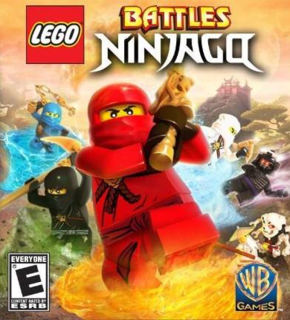Lego Battles: Ninjago is a Lego themed game that takes place within the world portrayed in the Lego Ninjago TV show. It is a little different than most of the Lego games that have come along so far in that it is less of an action game, and more of a tactical/strategy affair. You take control of Sensei Wu and his four ninja acolytes Jay, Cole, Zane and Kai, on a quest to find and protect the four weapons of power from the evil Lord Garmadon and his skeleton army. The action unfolds in a number of different arenas where you must build your forces up by creating various buildings, builders and warriors, in an effort to best the opposing army while achieving any other mission objectives along the way. Do you have both the brawn and the brains to outwit Garmadon and his minions?
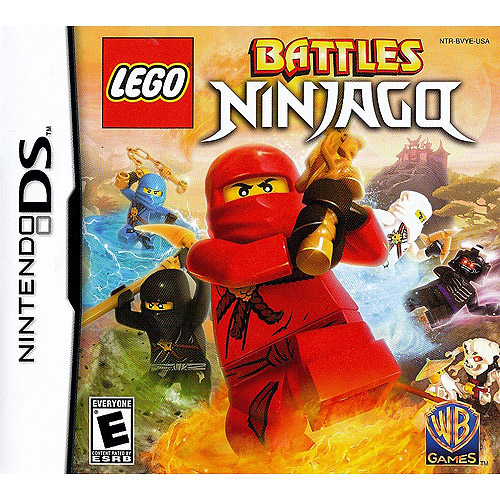
This game doesn’t have a traditional type of main menu, per se. When you start the game you will come to the title screen, where you first create and from that point onwards load your game save file (you can also delete any game save files from this screen). Once your game is loaded you are taken to the game’s hub, which takes the form of a dojo. In this main area of the dojo there are a few different places you can visit. One is a small building on the far left side of the dojo, upon entering it you can view your “Conquests”. There are a large number of statues placed throughout all areas of the dojo. At first there is just a platform present where these statues will be, but as you perform certain tasks in the game (aka your Conquests) the statues will then become available to build atop these platforms. The tasks are many and they vary quite a bit, including constructing a certain amount of characters or buildings, destroying a certain amount of enemy characters or buildings, collecting a certain amount of bricks, Minikits, red bricks, and Lego studs, completing various modes of the game, and the list goes on. By visiting this building you can view the different Conquests you are tasked with pursuing and how far along you are in completing them.
Right next door to this building is a small open air structure which houses the “Lego Shop”. Upon entering this building you can view your game progress, including how many red bricks and minikits you’ve collected, your conquest rank (maximum level is 100), and your game completion percentage. There are some options you can choose to explore here as well. First is the “Character Collection” option. In total there are 32 playable characters in the game, most of which you have to unlock during the game and then use your accumulated Lego studs to purchase here in the Lego Shop. You unlock the characters by performing certain objectives during the game, such as gaining various conquest ranks, collecting certain minikits and red bricks, fully completing the game, playing on a special day, etc. Second is “Cheat Codes”, where you can input any 7 character cheat code you may have come across. Third is the “Help and Hints” option, where you can view quite a number of little tidbits Sensei Wu has to offer on playing Lego Battles: Ninjago. Next comes “Movies”, where you can view all of the unlocked gameplay cutscenes you’ve encountered on your adventure through the game. Then we have “Concept Art”, where you can purchase artwork related to the development of this title. And finally comes “Maps”, where you can purchase arenas to play in during the game’s alternate modes.
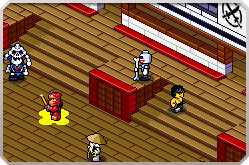
The final building you can visit in this main area is on the right hand side, up near the top. Here you can view and adjust the game’s “Options”, including sliders for both the music and SFX volumes, toggle the difficulty level (easy/normal/hard), toggle right/left handedness, toggle language (english/french/spanish), as well as viewing the game credits.
Now we move on to the actual game modes! To get to these modes there are a couple doors along the top wall of this main area of the dojo. We’ll start with the door on the left, which takes you to the game’s “Story Mode”. Once in this room beyond you are faced with three options. The door on the far left is what you enter to get to the “Training Room”. In the Training Room there are four more doors you can then enter, each of which takes you to a tutorial on various aspects of playing through Lego Battles: Ninjago, led personally by Sensei Wu.
The second door (the middle one) is what leads you to the “Ninjago Story” mode of the game, the main single player mode where your adventure will unfold. Once inside this next room you are faced with four more doors labelled in Roman Numerals I through IV, each representing an individual chapter of the Ninjago team’s journey through this game. Upon entering one of these doors you will then be faced with between 5-6 more doors, each of which holds an individual level within whatever chapter you happen to be in. Complete all levels in a chapter and you’ve finished that chapter and unlocked the next one for play . . . complete all chapters and you’ve beaten the game! The levels in this mode include: Chapter I (Darkness Returns, Destiny Awaits, Grasshopper, Brick Road, The Scythe of Quakes, Incoming), Chapter II (Frozen Approach, Ice Guardian, Path to the Clouds, In the Clouds, Down to Earth), Chapter III (Deep Sleep, Stolen Goods, Shadow Play, Awoken, Trapped by Fire) & Chapter IV (Traced Steps, The Rat, Storm the Gate, Castle Raid, The Confrontation).
The third and final door (on the right) is what takes you to the “Skeleton Story” mode of the game. That’s right, not only can you play with the good guys in this title, but you can also go back and replay it afterwards, this time as the evil skeleton army! This Skeleton Story mode works exactly the same as the Ninjago Story mode. Once inside the next room you are faced with four more doors labelled in Roman Numerals I through IV, each representing an individual chapter of the skeleton army’s journey through the game. Upon entering one of these doors you will then be faced with between 5-6 more doors, each of which holds an individual level within whatever chapter you happen to be in. Complete all levels in a chapter and you’ve finished that chapter and unlocked the next one for play . . . complete all chapters and you’ve beaten the Skeleton Story too! The levels in this mode include: Chapter I (Build your Army, Shortcuts, Tear it Apart, Incompetence, What’s that Rumbling?), Chapter II (Shape Up, Devastate, Dark Places, Walled In, Rattled), Chapter III (Icy Pass, Ice Storm, Antifreeze, The Chain Gang, Lightning Strikes, The Hermit) & Chapter IV (Into the Darkness, Shadow Puppets, Foresight, Unturned, Within Grasp).
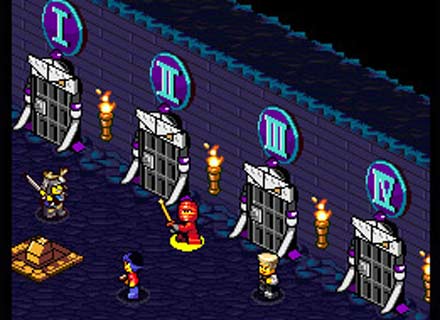
Heading back to the original, main area of the dojo, the other door along the top wall (the door on the right) leads you to the game’s “Battle Mode”. Once you head in this door you must first choose to play “Single Player” (you against the machine) or “Multiplayer” (you against other humans using the online function of your DS). Once that selection is made you then pick which type of game you’d like to play. The options available are Annihilation (your army takes on an opposing army, the first to wipe out all of the other’s units and structures wins), Capture the Flag (each army has to protect it’s own flag while attempting to steal the other army’s flag a certain number of times), King of the Hill (each army tries to take control of a central location and maintain their grip on it for a certain period of time), Brick Race (each army sets their builders to work harvesting bricks as fast as possible, while the warriors harry the other army’s builders, the first to reach a certain total amount of bricks wins), Goliath (your army is simply tasked with taking down a giant beast within a certain time limit, such as a dragon or large rock monster) & Survival (your army has to withstand endless waves of opponents for as long as possible). In the Multiplayer version the Goliath and Survival games are not available. Anyhoo, once you decide on your game type you must then choose what arena you want to compete in. Afterwards your last task is to set any stipulations particular to the game type. These stipulations include things like toggling prebuilt bases on/off, toggling starting bricks 500/2000/5000, toggling random start locations on/off, setting the target number of points or objectives, toggling the timer off/10/20/30, etc. Once you make these decisions you are then taken to the arena and your combat begins!
Once you are out and about in the game there are quite a few things to watch out for. First of all are the Minikits, which take the form of a golden statue. There is one present in every Story Mode level, by collecting them you add to your game completion percentage not to mention helping to unlock characters, conquests, etc. Also present in some of the Story Mode levels but not all of them (16 in total) is a special Red Brick. By nabbing these special bricks you unlock certain extras that you can then access from the game’s pause menu. These extras act as cheats almost, which help make gameplay easier for you as you continue to progress through the game (cheats like one hit kills, harvesting bricks faster, revealing the entire level map, etc.). You will also come across piles of golden Lego bricks, sometimes on their own but more often clumped in groups of two or three. These are the piles of bricks that you set your army’s builders loose on, they harvest these bricks and use them to build structures, more builders, and warriors for your army. You also have to be on the lookout for various environmental objects, mostly they come in the form of trees but you can also find rocks, plants, flowers, and bricks. You can destroy these objects to reveal varying amounts of Lego studs which are up for the taking. Lego studs are what you use to purchase extra characters, game arenas, etc., and if you collect enough in each level you will earn “True Ninja” status for that level, which contributes towards your game completion percentage. Another major thing to be on the lookout for is your enemy of course, both in the form of living beings and the structures they build. By destroying your enemy you will gain the Lego studs they drop, as well as any booster packs they have on their person. Booster packs are special items that bolster your own characters’ abilities in attack, defense, etc. Finally, you have to be on the prowl for random items every once in a while, some of which are lying around, others that your enemy might be carrying with them and you have to steal. These types of items include keys, lightning rods, portals, and more.
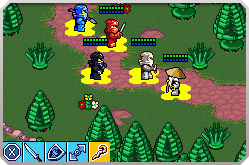
Now for the game screen(s). The bottom screen is where all the gameplay unfolds. In the top left hand corner of this screen you’ll find an exclamation mark. By tapping on it your current objectives will be displayed, in case you lose your way. In the bottom left corner a row of mostly blue icons will appear, which ones show up there totally depends on what type of character or building you are currently in control of. The icons can include a shield with an X in it (stop current action), a sword (attack), a shield (defend), an arrow (set patrol perimeter), and a red book (initiate upgrades, most characters have two levels of upgrades to their abilities possible, while a small few only have one). These are the icons that show up if you are in control of your warriors. Note that after you upgrade your warriors new yellow icons will show up in the bottom right corner of the screen and represent your chosen warrior(s) special powers (the powers mostly focus on attack but some are for defense and healing too). As for your builders, their icons differ slightly, including a shield, sword, hammer (used to repair damaged buildings), followed by a keep, barracks, tower, brick bank, and mine (these are the five types of buildings you can construct in this game, tap on them to have your builder create them). Now, if you are in control of a building the icons change to include a detonator (destroy selected building), an image of one of your builders (used at the keep only, it creates additional builders for you to a maximum of 6), a paper scroll (at the keep only, it brings up an index of upgradeable characters and buildings, you can then choose to initiate said upgrades from this screen), images of the various warriors included in your army (at the barracks only, they create the applicable warriors for you), and a red book (it also initiates upgrades, but only on towers, there are four different upgrades you can perform, each representing a different type of attack). Just above all units in the game (characters and buildings, both allies and enemies) a health bar will appear. It starts off green and turns to red as the unit in question takes damage. When it runs out completely said unit is destroyed. Just underneath this health bard (for your own warriors only) is an energy bar, letting you know how much energy you have available to spend on that character’s upgraded attacks/abilities. As for the top game screen, it is where cutscenes, movies and subtitles are displayed. During gameplay you can find the level/arena map up there, as well as vital information on your currently selected character or building. Your current Lego stud and Lego brick totals appear there too. A little off topic now, before each level begins you are given a brief overview of your objectives on these screens, while after the level a detailed summary of your progress is broken down. Stats like play time, booster packs, studs and bricks collected, structures and characters built, structures and characters destroyed, etc. is all on display for you to peruse.
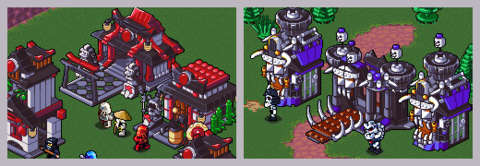
As for the pause screen, when you halt the action the menu that is displayed gives you five options to choose from. Said options include: Resume, Objectives (lists your current main objectives, the same thing you get by tapping the exclamation mark on the game screen), Red Bricks (where you go to view a list of the Red Bricks you have collected and the applicable extras they represent, this is also the screen where you can turn these extras on/off), Restart, and Quit.
Next come the game controls, and they can for sure be quite confusing until you’ve played the game for a good while and gotten used to the whole concept of it. First of all, you can use the stylus on the bottom game screen to pretty much interact with anything. You use it to tap on the exclamation mark to bring up your objectives, on the blue and red icons to perform actions for your characters and buildings, and also on the yellow icons to make your warriors execute their upgraded attacks/abilities. To take control of a character or building, simply tap on them. To control a group of characters, tap and hold the stylus on the screen, then drag a box around all the characters you want in your roving posse. Tap on an area of the level to make your character(s) to go there, and to engage an attack on an environmental object or enemy simply tap on the object or enemy in question. Other controls to be aware of include the analog button (or the control pad), use it to pan your camera view of the level map to wherever you want, whether you have any units in the area or not. The R button you can use to bring up a list of all the characters you currently have built and in play in the level, from here you can choose to control/decontrol whichever ones you want. The X button is used to toggle the game screens, flipping the displays. As for the Y button, it is used to quickly flip control between the various warrior character you have in play at the current time. Finally, the Start button pauses the game.
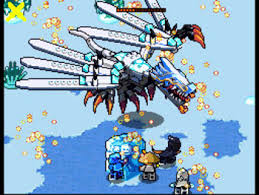
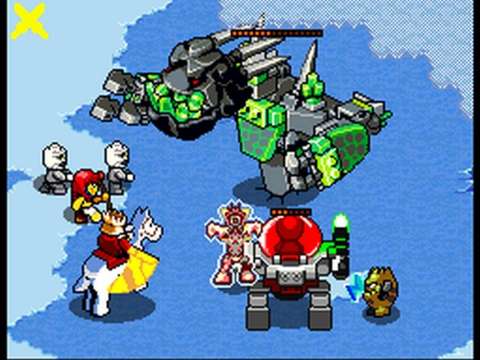
This game’s presentation is pretty solid. It’s not an outstanding looking game or anything, but that has more to do with the nature of the game than anything. It’s not supposed to be a slick action game boasting the latest and greatest engine, it’s more of a utilitarian type of strategy game like Civilization and such, where the look of the game is secondary to the unique theme and the execution behind it. Despite this the graphics are good, clean and crisp, although not amazing. The levels are very colourful and vibrant, and it fits in quite well with the rest of the Lego universe. The sound is a little lacking as there is no real game music per se, but the sound effects are good as are the cutscene movies. As for the controls, they can take quite a while to get used to, but once you get on to them it’s very easy to navigate your way around this game and it’s various features. And with almost everything being done with the stylus it’s pretty much one stop shopping in that regard!
There is much upside to this game. Under the pros column I found that the unique type of game it is was one of the most important features, in my opinion. There aren’t many strategy type games out there, especially ones that borrow from such a cool universe, so I found it to be a very different and interesting type of game. Also, the game is ginormous. You’ve got well over 40 Story Mode levels, some tutorials, and then a half dozen different Battle Mode game types as an alternate game mode. That is a lot of game for such a low price! Plus there is lots of stuff to look out for in the game which keeps things interesting, and in turn allows you to access a lot of unlockable content like additional characters, concept art, arena maps, etc. My final major pro is that the game was based on the Lego: Ninjago cartoon. My son and I just watched the first season of this show not too long ago and we both loved it, so getting in to this game and getting to play around with it’s familiar elements was pretty awesome. On the downside, the only con I could think of is that sometimes the Story mode levels can seem a bit repetitive, but that was a very minor issue in my opinion.
As for tips and tricks I can offer future players of this game, I do have a few nuggets up my sleeve. First of all, take your time. Sometimes the characters in the game (during cutscenes) make it seem as though you have to go after your objective right away, but this is false 99% of the time. Mostly you can take your time to mosey around the level, eradicate any enemies you come across, collect your unlockables like Minikits or Red Bricks, and collect enough studs to gain True Ninja status before moving on to actually completing the level. I find this the way to do things as you will then make sure you have gotten everything you need out of the level and won’t have to go back and replay it for any missed items or tasks. Also, and this goes hand in hand with what I just said, but focus on finding the Red Bricks asap. The extras they contain really make life easier as you proceed through the game, so getting them and using them as you go is important. Finally, when you start out on a new level that involves you using your builders, search for a suitable area to harvest bricks asap and get them going on it right away. The sooner you set up your war machine and get it’s defenses in place, the better off you’ll be. You’ll get a big jump on your enemy and have an easier time of eventually eradicating them. So set up shop first, then go out and explore!
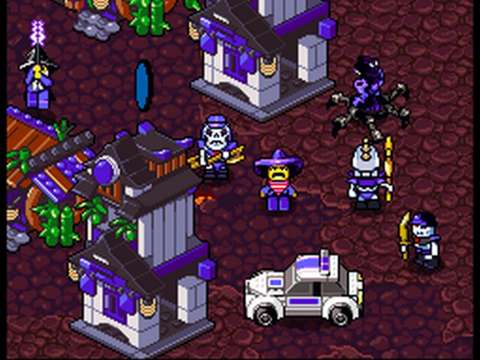
Overall this is a really good game, I would give it an 8.5 out of 10. Although I quite enjoy it’s unique nature I still like the traditional types of Lego video games better, but this is definitely a worthy foray in to the unusual. With the game’s upside far outweighing any negatives, and coming in at a low price to boot, you can’t go wrong with Lego Battles: Ninjago!
